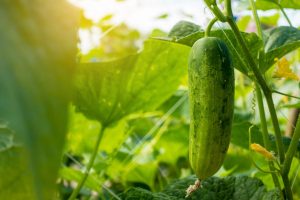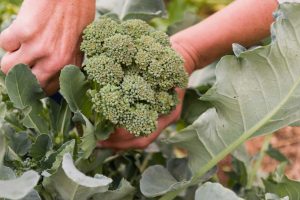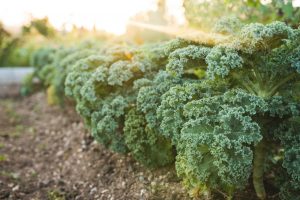

Growing Brussels sprouts requires cool weather. The ideal climate is the “fog belt” of the Pacific Northwest, but they will grow in just about any part of the country. A slow-growing, long-bearing crop, Brussels sprouts should be planted in early spring, or mid- to late summer for a crop that matures in the fall. The small heads mature best in cool and even in light frosty weather. Spring planting is also fine in cooler climates. Be aware that sprouts maturing in hot or dry weather will be flimsy and bitter. Brussels sprouts belong to the cole crop family (Brassica oleracea), which includes cabbage, broccoli, cauliflower, collards, kale, and kohlrabi.
Soil, Planting, and Care
Like most vegetables, Brussels sprouts need a minimum of 6 hours of sunlight daily; more is better. They like fertile, well-drained, moist soils with plenty of organic matter. The soil pH should be on the high side of the range for vegetables, about 6.8, for optimum growth and to discourage clubroot disease. To be sure about pH, get the soil tested. You can buy a test kit at a well-stocked garden center, or have a soil test done through your regional Cooperative Extension office. Apply fertilizer and lime using the results of the soil test as a guide.In the absence of a soil test, incorporate plenty of nitrogen-rich amendments to the soil. These include blood meal, cottonseed meal, or composted manure. Or, work a timed-release vegetable fertilizer such Miracle-Gro® Shake ‘N Feed® Tomato, Fruits & Vegetables Plant Food.
Brussels sprouts also need more boron than most other vegetables. Boron is a plant nutrient used in minute quantities by all plants; without it, Brussels sprouts develop hollow stems and small buds. If your plants have shown these symptoms, you can add boron to the soil by dissolving 1 level tablespoon of borax (such as 20 Mule Team from the grocery shelf) in 5 quarts of water and sprinkling it evenly over 50 square feet of bed. DO NOT be tempted to mix more, because too much causes problems. Also, do not apply unless your plants have shown the deficiency symptoms we just mentioned.
Set plants at the spacing on the Bonnie label. Brussels sprouts get large, so they need to be about 18 to 24 inches apart in a row or bed. If planted in rows, space rows 30 inches apart to give yourself enough room to walk. Don’t let seedlings sit around for long, dry out, or get stunted in their pack. Plant right away.
Water thoroughly after planting to encourage good growth. Mix in some Miracle-Gro® Shake ‘N Feed® Tomato, Fruits & Vegetables Plant Food, or a starter fertilizer solution of fish emulsion or 20-20-20 mixed according to label directions. Mulch to keep the ground cool and moist. Water regularly, applying 1 to 1 1/2 inches of water a week if plants don’t receive enough rain.
Troubleshooting
Insects that attack Brussels sprouts include harlequin bugs, cabbage loopers, diamondback moth, imported cabbageworm, cutworms, cabbage maggot, thrips, and webworms. Aphids can be especially difficult to control. Plants can also be bothered by powdery mildew and rust.
Harvest and Storage
Sprouts first form at the bottom of the plant and continue forming toward the top for several weeks. Brussels sprouts are ready to harvest when the tiny heads are firm, green, and 1 to 2 inches in diameter. Remove sprouts by twisting them until they break away from the plant. As you remove the lower sprouts, you can also remove yellowing leaves; the plant continues to grow upward, producing more leaves and sprouts. The plant will withstand frost and can be harvested until a hard freeze strikes. The best-quality sprouts are produced during sunny days with light frosts at night. As winter approaches, you can trick the sprouts into maturing all at once by cutting off the top of the plant about 3 weeks before you want to harvest.One full-sized, healthy plant can bear 2 to 3 pounds of sprouts. They come quickly at first but will slow down as the weather gets colder. Once a sprout is picked, new ones will not form in that spot. Full-grown sprouts keep well on the plant in cold weather, making them a great winter harvest item for gardeners in the South (planted in fall). In cold climates, gardeners often bury Brussels sprouts plants up to their tops in hay or leaves in late fall, then pull off the little sprouts as needed through winter.
Store fresh, unwashed sprouts in plastic bags in the refrigerator. Fresh sprouts taste best, though, so try to limit refrigeration to a day or two. And don’t toss the leaves! Cook them as you would collards — they’re delicious.



